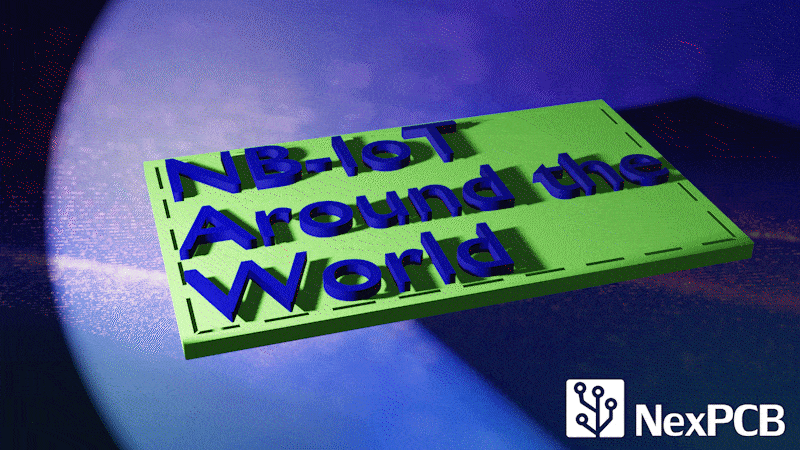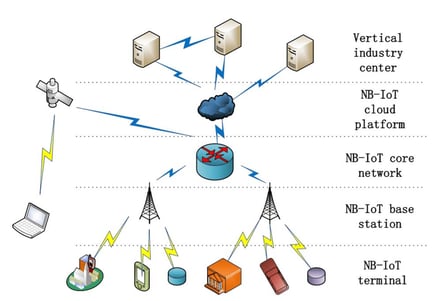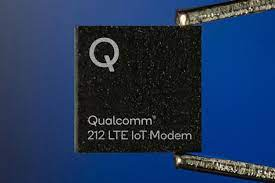NB-IoT Networks You Can Start Using Today (Worldwide)
NB-IoT is an LPWAN technology that is widely used around the world due to its secure, wide-coverage, and fast transmission capability. Having to run in parallel with cellular network operators, the operating conditions and choices are discussed around the globe: its architecture, devices, and support required for a maximized performance.

NB-IoT or the Narrowband Internet-of-Things technology had been one of the epitomes of 5G M2M (machine to machine) technology in recent years, operating as the Release 13 (CAT-NB1) and Release 14 (CAT-NB2) of the 3GPP Standard. Being one of the LPWAN (Low Power Wide Area Network) technologies, NB-IoT ensures a wide, fast, efficient, and reliable data transmission by being deployed into a licensed band of a cellular network.
Like any other communication technology, data transmission should be carried out within a range of frequencies. The choice of these frequencies depends on the region on which the NB-IoT is implemented which will be discussed further in the following sections. With a bandwidth of only 200 kHz and a half-duplex transmission technique, the NB-IoT technology ensures a low power consumption, estimating a battery life of more than 10 years.
NB-IoT Frequency Bands
NB-IoT can be deployed in three different operation modes: in-band with LTE carrier, guard band with LTE carrier, and stand-alone operation with GSM carrier. Along with this, NB-IoT is also able to operate in all 2G, 3G, and 4G bands, apart from its default 5G or 3GPP standard.

The bands used for these operations are licensed by the 3GPP TS 36.101, in which the frequency bands per region are defined by numbers, as shown in the table below.
|
Region |
Registered Band No. |
|
Europe |
3, 8, 20 |
|
Commonwealth of Independent States |
3, 8, 20 |
|
North America |
2, 4, 5, 8, 12, 20, 26, 66, 71 |
|
Asia Pacific |
1, 3, 5, 8, 18, 20, 26, 28 |
|
Sub-Saharan Africa |
3, 8 |
|
Middle East |
8, 20 |
|
South America |
2, 3, 5, 28 |
In which the bands and their respective uplink and downlink ranges are further defined below.
|
NB-IoT Band No. |
Uplink |
Downlink |
|
1 |
1920 MHz – 1980 MHz |
2110 MHz – 2170 MHz |
|
2 |
1850 MHz – 1910 MHz |
1930 MHz – 1990 MHz |
|
3 |
1710 MHz – 1785 MHz |
1805 MHz – 1880 MHz |
|
4 |
1710 MHz – 1755 MHz |
2110 MHz – 2155 MHz |
|
5 |
824 MHz – 849 MHz |
869 MHz – 894 MHz |
|
8 |
880 MHz – 915 MHz |
925 MHz – 960 MHz |
|
12 |
699 MHz – 716 MHz |
729 MHz – 746 MHz |
|
18 |
815 MHz – 830 MHz |
860 MHz -875 MHz |
|
20 |
832 MHz – 862 MHz |
791 MHz -821 MHz |
|
26 |
814 MHz – 849 MHz |
859 MHz – 894 MHz |
|
28 |
703 MHz – 748 MHz |
758 MHz – 803 MHz |
|
66 |
1710 MHz – 1780 MHz |
2110 MHz – 2200 MHz |
|
71 |
663 MHz – 698 MHz |
617 MHz – 783 MHz |
NB-IoT Network Configuration

Unlike LoRaWAN, an NB-IoT network doesn’t require any gateways for its operations. The NB-IoT devices are implemented by chips and/or SIM cards, enabling communication between the NB-IoT core network and the end devices. The transfer of information was done through the base stations of the registered cellular networks.
When designing a product, some of the components to be prepared for the infrastructure include the chipsets, modules, up until the individual devices (such as sensors), which could be obtained from companies such as Huawei, Qualcomm, and ublox.

NB-IoT Networks
NB-IoT was first designed for Europe and Asian markets in 2016. The market was then further extended to Australia, North America, and South America, establishing 2 operators (AT&T and T-Mobile) in the US in 2019. Up until now, the country to use the most NB-IoT technology is still China, with China Telecom claiming to establish more than 100 million connections by May 2021.
Based on data from GSA (Global mobile Suppliers Association), per April 2021, there are 165 operators actively investing in NB-IoT technology, of which 120 have deployed the networks in 64 countries, 25 are planning and/or piloting networks, and 20 are evaluating and/or trialing.
Another database by the GSM Association states that by July 2021, 106 NB-IoT networks across different countries had been established, with the cellular operators listed in the table below.
|
Country |
Cellular Network Operator |
|
Australia |
Optus |
|
Telstra |
|
|
Argentina |
Telefonica |
|
Austria |
A1 |
|
Deutsche Telekom |
|
|
Bangladesh |
Grameerphone |
|
Belarus |
A1 |
|
Belgium |
BASE (Telenet) |
|
Orange |
|
|
Proximus |
|
|
Telenet |
|
|
Brazil |
TIM |
|
Telefonica |
|
|
Bulgaria |
A1 |
|
Canada
|
Rogers |
|
China |
China Mobile |
|
China Telecom |
|
|
China Unicom |
|
|
HKT |
|
|
Smartone |
|
|
Columbia |
Telefonica |
|
Croatia |
A1 |
|
Czech Republic |
Deutsche Telekom |
|
Denmark |
TDC |
|
Telenor |
|
|
Tella |
|
|
Estonia |
Elisa |
|
Tella |
|
|
Finland |
DNA |
|
Elisa |
|
|
France |
SFR |
|
Germany |
Deutsche Telekom |
|
Telefonica |
|
|
Greece |
Deutsche Telekom |
|
Wind |
|
|
Hong Kong SAR |
3 Hong Kong |
|
China Mobile |
|
|
HKT |
|
|
Smartone |
|
|
Hungary |
Deutsche Telekom |
|
India |
Reliance Jio |
|
Indonesia |
Telkomsel |
|
XL Axiata |
|
|
Ireland |
|
|
Italy |
TIM |
|
Vodafone |
|
|
Japan |
Softbank |
|
Kazakstan |
Kcell |
|
Latvia |
LMT |
|
Lithuania |
Tella |
|
Malta |
|
|
Malaysia |
Maxis |
|
Netherlands |
Deutsche Telekom |
|
New Zealand |
Verizon |
|
Norway |
Telenor |
|
Tella |
|
|
Pakistan |
Telenor |
|
Poland |
Deutsche Telekom |
|
Portugal |
Altice |
|
NOS |
|
|
Qatar |
Ooredoo |
|
Romania |
|
|
Russia |
Megafone |
|
MTS |
|
|
Saudi Arabia |
Mobily |
|
STC |
|
|
Serbia |
A1 |
|
Singapore |
M1 Singapore |
|
SingTel |
|
|
StarHub |
|
|
Slovakia |
Deutsche Telekom |
|
Slovenia |
A1 |
|
South Africa |
|
|
South Korea |
Korea Telecom |
|
LGU+ |
|
|
Spain |
|
|
Telefonica |
|
|
Sri Lanka |
Dialog Axiata |
|
Mobitel |
|
|
Sweden |
Tella |
|
Switzerland |
Sunrise |
|
Swisscom |
|
|
Taiwan, Province of China |
APTG |
|
Chunghwa Telecom |
|
|
Taiwan Mobile |
|
|
Thailand |
AIS |
|
True Corperation |
|
|
Ukraine |
Kyvistar |
|
United Arab Emirates (UAE) |
DU |
|
Etisalat |
|
|
United Kingdom (UK) |
|
|
United States
|
|
|
Uruguay |
Antel |
|
Turkey |
|
|
Vietnam |
Viettel |
Based on the GSA, by April 2021, there are 362 devices supporting the CAT-NB1 protocol, and 7 device models supporting the CAT-NB2 protocol. These devices are implemented into various industries, such as agriculture, robotics, smart industries, cities, homes, smart energies, and autonomous vehicles.
Unlike LoRaWAN and other mobile services such as LTE communication devices, the NB-IoT has very limited mobility. Instead of allowing multiple handshaking procedures, the NB-IoT’s mobility is only supported by the cell reselection technique, which limits its performance. Despite this, NB-IoT was designed to allow a fast data transfer rate with deep indoor penetration, hence applications such as remote monitoring would operate well using the NB-IoT technology.
Another solution: LTE-M
Having a similar working operation as the NB-IoT, the LTE-M, also known as the eMTC (enhanced Machine-Type Communication) feature of the 5G or 3GPP standard, is claimed to be able to have a stronger network transmission (faster data exchange speed) with lower latency than NB-IoT. However, it’s limited by its high power consumption and coverage, especially when applied to assist in indoor penetration.
Posted by Nadya Lukman

Nadya is a Mechatronics Engineer who had worked on several different projects including PCU design, engine design, and AI image processing systems. Besides having a little bit of caffeine addiction, she enjoys reading and traveling to new places.
